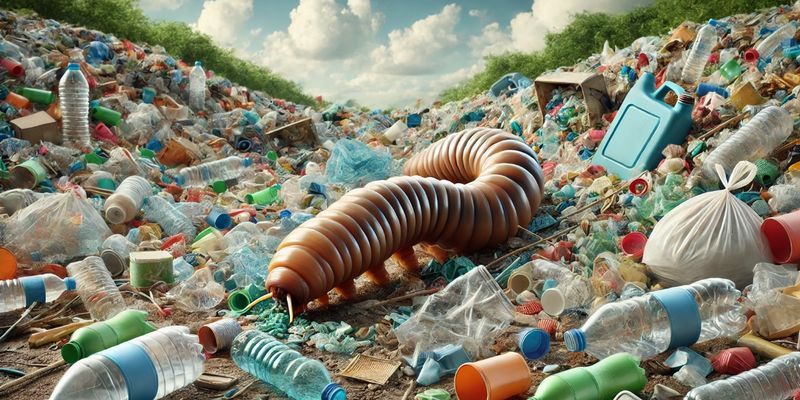In a breakthrough that has captivated scientists and environmentalists alike, researchers have identified a plastic-eating insect that could dramatically reshape the way we handle waste. The larvae of the Kenyan lesser mealworm, a species of darkling beetle, have shown a remarkable ability to consume and degrade polystyrene, one of the most persistent and problematic plastic pollutants. This discovery could be a game-changer in addressing the global plastic crisis, offering a natural and efficient alternative to traditional recycling methods.
The Gravity of Plastic Pollution
Plastic pollution has emerged as one of the most pressing environmental challenges of our time. Every year, over 8 million metric tons of plastic waste enter our oceans (that’s equivalent to a Statue of Liberty’s worth of plastic waste entering the ocean every hour) according to a report by the United Nations Environment Programme (UNEP). With global plastic production surpassing 380 million tons annually, much of it being non-biodegradable, the world is grappling with an overwhelming plastic burden.
Polystyrene—a key target of this discovery—is particularly challenging. Commonly used in packaging, disposable cutlery, and insulation, polystyrene is notorious for its durability and resistance to breakdown. The material takes hundreds of years to degrade, contributing significantly to microplastic pollution that threatens ecosystems and human health. Recycling rates for polystyrene remain dismally low, often under 10% globally, due to the high costs and technical challenges of processing it.
Enter the Kenyan Mealworm

The spotlight now shines on the Kenyan lesser mealworm larvae, scientifically known as Alphitobius diaperinus. Researchers at the International Centre of Insect Physiology and Ecology (ICIPE) in Kenya made the groundbreaking discovery that these larvae can consume and metabolize polystyrene. This is the first documented case of an African insect species exhibiting such capabilities, marking a major milestone in the fight against plastic pollution.
In controlled lab experiments, scientists fed the larvae various diets, including polystyrene, bran, and a combination of the two. The results were astounding: when fed a mix of polystyrene and bran, the larvae not only survived but managed to degrade 11.7% of the polystyrene in just one month. This efficiency highlights their potential as a natural solution for managing plastic waste.
The Science Behind Their Superpower
The secret to these larvae’s plastic-munching abilities lies in their gut microbiome. Specific strains of bacteria, including those from the genera Kluyvera, Lactococcus, and Klebsiella, produce enzymes capable of breaking down polystyrene. These enzymes depolymerize the long plastic chains into simpler compounds, which the larvae then metabolize for energy.
Scientists are now focusing on isolating and studying these enzymes, hoping to replicate their functionality on a larger scale. By understanding the biochemical pathways involved, researchers aim to develop microbial or enzymatic treatments to degrade plastic waste more effectively.
Why This Matters Globally
Globally, the implications are even more profound. Traditional recycling methods, while effective in some contexts, are often energy-intensive, expensive, and limited in scope. By contrast, biological solutions such as those offered by mealworms could provide a low-cost and scalable alternative. This is particularly significant for polystyrene, which has long been considered one of the hardest plastics to recycle.
Potential Applications and Challenges
While the discovery of plastic-eating mealworms is exciting, it’s important to temper expectations with practical considerations. Scaling up the use of mealworms for waste management would face logistical challenges, not least because maintaining and feeding vast populations of larvae is resource-intensive.
The real promise lies in the enzymes produced by these larvae. Scientists envision a future where these enzymes are synthesized and deployed on an industrial scale to treat plastic waste in landfills, oceans, and urban environments. The ability to engineer these enzymes for use in bio-reactors could revolutionize waste management systems globally.
However, there are hurdles to overcome. Research is needed to ensure that these enzymes can be produced efficiently and sustainably. Moreover, their efficacy against other types of plastics, beyond polystyrene, remains an open question.
The Bigger Picture: Nature’s Role in Sustainability
This discovery underscores the potential of nature-inspired innovations in solving human-made problems. From algae-based biofuels to fungi that can degrade oil spills, leveraging the power of biology offers a sustainable path forward. Plastic-eating larvae join a growing list of biological solutions that could help mitigate environmental damage while reducing reliance on energy-intensive technologies.
Plastic: Meet Your Maker
To borrow a phrase from nature, “one worm’s trash is another worm’s treasure.” As scientists continue to explore the incredible potential of these plastic-eating larvae, the hope is that this small insect will inspire a big movement toward sustainability. After all, if a tiny worm can tackle our plastic problem, surely we can muster the willpower to support and scale such efforts. Let’s turn the tide on pollution—one mealworm at a time.










